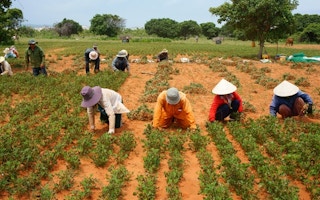Protecting the world’s dwindling forests and making small farms more productive will cost hundreds of billions of dollars annually - money governments and charities do not have to spend, experts said at a London conference.
Private investors could fill the gap, they said - but only if environmentalists and finance experts work together to create investment products that are financially attractive and effective in creating the right kind of change on the ground.
“There are trillions of dollars of money looking for a home,” said Mark Burrows, a longtime investment banker with Credit Suisse.
Getting investors to put that money into protecting the world’s “landscapes” will be crucial as governments and philanthropists can provide “only a tiny, tiny portion” of what is needed, he said.
“Without the private sector, you will all be terribly virtuous in what you’re doing.
“But being virtuous doesn’t achieve the result you want. It’s important you understand that,” he told forest and farming experts at a conference on investing in global “landscapes” at the Royal Society in London.
“
We need to understand, ‘Is it feasible to do this? Is it having the impact we desire? Is it a fair deal?’
Elvira Lefting, managing director of Finance in Motion
But effectively bringing together people who see the world in very different ways - “equity” means “ownership” to investors and “fairness” to environmentalists and small-scale farmers - will be a huge challenge, those at the conference admitted.
Engaging with communities involved in forestry or farming is “the most difficult part of developing a bankable project”, said Bill Rahill, who leads on environmental and natural resources issues for the World Bank.
For projects to work, those building them need to know what is happening on the ground and be prepared to deal with conflicts over issues such as land tenure, he said.
Early experiments with REDD+ - a UN supported effort to have rich nations pay poorer nations and communities to protect their forests, in exchange for receiving tradable carbon credits - have run into a range of problems.
These include a collapse in the value of carbon credits and rejections by some communities who feel they have not been adequately consulted in the set-up of projects.
Expecting the UN-backed Reducing Emissions from Deforestation and Forest Degradation (REDD) effort to effectively protect many forests has proved “too simplistic”, said James Ranaivoson of the European Investment Bank.
“We need to be very, very local in our solutions,” said Elvira Lefting, managing director of Finance in Motion, a Frankfurt-based investment group focused on development finance.
“We need to understand, ‘Is it feasible to do this? Is it having the impact we desire? Is it a fair deal?’,” she added.
Daniel Gad, an Ethiopian farmer and member of the World Farmers’ Organization, questioned whether lending money to small farmers at market interest rates sufficient to attract investors was the right thing to do in some countries.
Market interest rates might be cheaper than borrowing from local informal money lenders, the only other source of finance, he said.
But “you’re heading for serious trouble when farmers are being forced to pay up to 35 per cent on unsecured loans”, he warned.
Eager to be “green”
Investment experts at the conference said a range of obstacles stand in the way of scaling up private investment in forests and small-scale farming, from uncertain risks to a demand for quick returns on long-term projects.
Dealing with lots of small, often very different projects in different countries also can be a problem, they said.
“Not all interventions are financeable with private money,” said Leslie Durschinger, who leads the Terra Bella Fund, a private equity fund focused on agriculture and forests.
In many cases, donors or government money will be needed to reduce the risk to commercial investors, she said, and simply finding ways to make money from small-scale farming or forest protection, at a commercial scale, can be very difficult.
The good news is that many companies are under growing pressure to reduce deforestation in their supply chains, which means they are “engaging very seriously” on things like sustainable farming, said Bernard Giraud, a sustainability leader at food company Danone.
And there is evidence investors are happy - or even eager - to put their money into “green” investments if they provide a sufficient return, the experts said.
Fabian Huwyler, a sustainability vice president at Credit Suisse, said his investment group believed wealthy investors and pension funds could put $200 billion to $300 billion a year into project if market-rate returns are offered.
That is a significant share of the $300 to $400 billion a year that is likely needed to protect nature, he said. Right now, the world spends about $50 billion mostly in public and charitable funds on such efforts, he said.
Leveraging the needed money will require getting forest and farming experts and bankers to learn each others’ language, and create financial products that work for both, said James Cameron, a co-founder of Climate Change Capital.
“I think there are huge possibilities for combining the interests,” he said.










